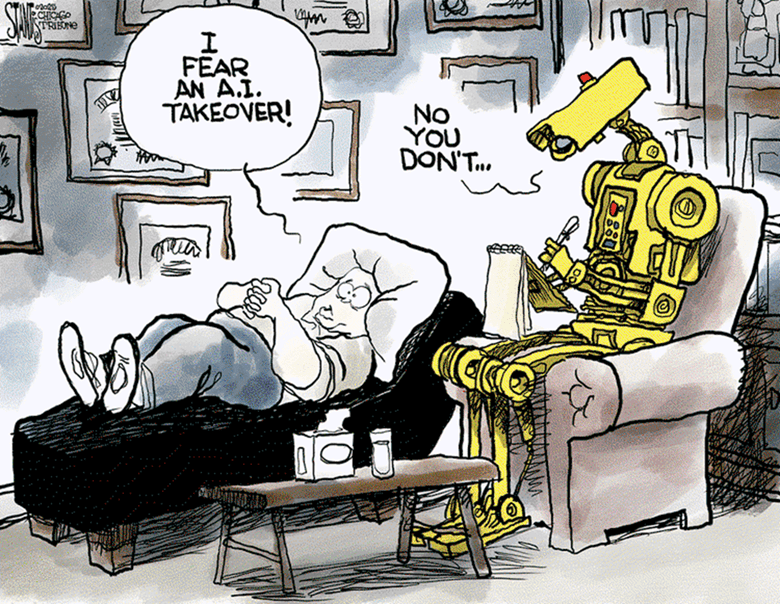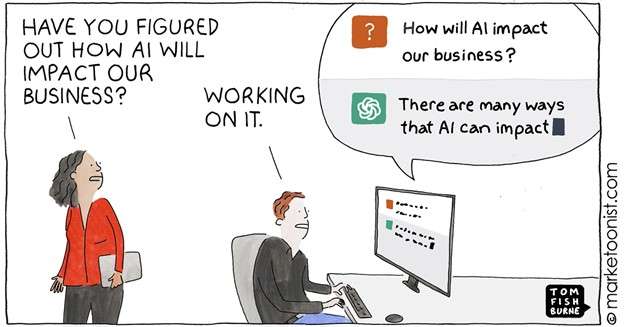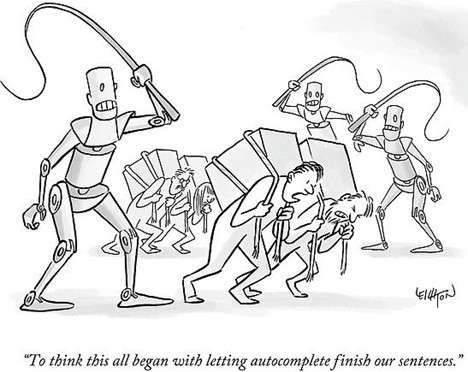
09 Aug Transformational Change is Coming
“No one needs a weatherman to know which way the wind is blowing.” – TLR Channeling Bob Dylan
Transformational change is being wrought by artificial intelligence (AI)…, and there is little to hold it back. Its benefits and burdens soon will be more widely felt. Paradigm-shifts are like Hemingway bankruptcies – they happen gradually, then suddenly. The reason why 2025 has not been “The Year of AI Transformation” is that AI has subjected itself to three constraints. Each soon will may be overcome.
The first is a self-imposed constraint – “the Victor Frankenstein danger,” the fear that AI will challenge human survival, that computer “monsters” will develop sentience and dominate homo sapiens. The consequence is that all most of those involved in AI development are proceeding cautiously, and more slowly, than they otherwise would. That has been true so far, but is changing as research (and the money poured into research) accelerates. The second constraint is the fear of “economic repression,” a commercial risk that computerization will repress and restrain the economic activities of people and of society in general. Economic repression means that entire employment sectors – human jobs – will be lost to robots and computers. This is the 21st Century’s version of Ludditism, a reference to those 19th Century workers who opposed adoption of the new, disruptive technologies of the Industrial Revolution because their careers and jobs were jeopardized and, often, eliminated. Today’s jobs are threatened by the AI Revolution. These two constraints are in addition to the operational problems experienced by AI’s Large Language Models (LLMs). These include hallucinations (that is, computerized delusions), data errors, and the damage computers cause by atrophying weakening human cognitive skills.
Luddite-inspired job displacement risks are real and their global impact is mounting. Goldman Sachs has projected that AI soon could replace displace 300 million full-time jobs. MIT/Boson University estimates that 2 million manufacturing jobs will be lost this year alone. Several think-tanks (including the World Economic Forum and McKinsey) are forecasting that current workforce reductions are signs of more significant layoffs to come, with 41% of employers worldwide indicating that they intend to reduce their workforce in the next five years due to AI. The fact is that repetitive manufacturing tasks (assembly line, quality control and machine operations) are easily automated by more efficient robotic systems. Computerized data entry, bookkeeping, receptionist, call center, purchase order and troubleshooting tasks today can capably (and more efficiently) process, input and interact successfully with humans. Financial analysis, loan processing, accounting and investment research all can be accomplished faster and more accurately by LLMs. And autonomous driving (for trucking and taxi tasks), inventory management and delivery (by drone and otherwise) are ready-made for LLMs and robotic systems. What is clear is that there already has been significant job transformation as humans and the tasks they perform are gradually being replaced by AI. What also is clear is that the process has barely begun – there will be wholesale replacement in production line manufacturing, data-driven processes in the financial sector, inventory management, customer service, autonomous vehicle transportation, and routine services. What makes this inevitable is that, once operations are converted to AI, the payoff is huge: robots are capable of producing goods repetitively, 24/7, with little to no human intervention, no coffee breaks, no unions, no overtime, no HR, no birthday parties. At this time, estimates are that 50% of businesses have integrated AI into their operations and that 14% of workers have experienced some job displacement. There’s more to come.
These AI negatives are being ignored because of counterbalanced by AI’s benefits, including by enhancement of human productivity, some of which already has become apparent (as summarized here by Michael Cembalest). For example, 60% of schoolteachers used AI this past school year to plan lessons, create assignments and complete administrative work. Teachers who use AI every week saved the equivalent of 6 weeks per school year. Weekly AI users saved twice as much time as monthly users. Over half of teachers using AI reported that it improved the quality of their work. From December 2024 to April 2025, the share of U.S. adults using LLMs at work rose from 30% to 43% (however only 1/3 of these adopters used the tool every workday). For tasks where LLMs were used, average completion times fell from 90 minutes to 30 minutes. LLM usage is most prominent in customer service, marketing and tech. The World Economic Forum has forecast that while AI would displace 85 million jobs by 2025, it will have created 97 million new ones. That, at least, is the hope.
The data, although early and varied, indicate that while AI indeed has displaced certain jobs and will continue doing so, it will simultaneously create new opportunities and enhance many existing roles. What those opportunities and enhancements might will be are unclear at this early stage in the transformational process. Nevertheless, AI talk has been hyping LLMs as a technology that will “change life as we know it.” Microsoft, Google, Amazon, Meta, et al, are in an AI capital-spending spree to gain market share – estimates are that they will spend $350 billion this year alone on capex (mostly for AI data centers). The Magnificent 7 currently have a huge share of stock market capital comprising more than 35% of the S&P 500’s market cap. The ratio of capital invested to revenue generated – with revenue having been minimal to-date – suggests that a transformation had better must be imminent. If not, stock markets will pay the price be disappointed.
Productivity – Schumpeter’s “creative destruction” – is the key to unlocking economic growth, particularly when populations have ceased growing or are reversing as they are today. Homo sapiens needs increased productivity. This is why our civilization is so much wealthier today than it was in the past. During the height of the Industrial Revolution, there was destruction of all sorts of suboptimal jobs that were no longer needed and that allowed adopting economies to create more wealth, that allowed people to do more with less, and that allowed our society to progress. Technology has always been the key to boosting productivity. AI is the latest step in that process and, indeed, will be transformational.
Finally (from a good friend)





No Comments